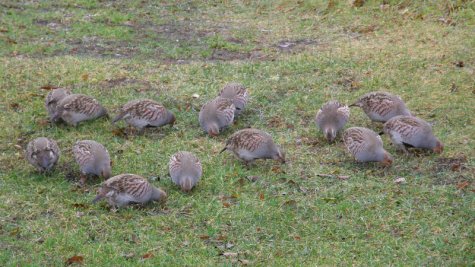Partridges in flocks
Photo sent by Ivan Plotnikov
Translation: Liis
Partridge; Grey partridge Nurmkana Perdix perdix
They are the birds of this year in Estonia and deserve some attention
By October the partridge flocks have been formed. The birds remain together until spring – in winter it is easier to get by in groups. They are sedentary birds and in Estonia spread along with agriculture. This is also indicated by the earlier Estonian name põldpüü, with põld meaning field
They only feed on the ground, on weed seeds, spilled grain, various parts of herbaceous plants, berries but also a little animal food – snails and arthropods. Habitats include fields and meadows, preferably close to thickets or forest verges; also river banks, forest clearings, pebble shores. In evenings we can meet partridge flocks at roadsides or forest clearing lines picking gravel grit.
Cocks and hens have rather similar greyish plumages. Length about 30 centimetres, weight about 400 grams. We find quite abundant colour in the plumage of partridges: the forehead as well as eye area and throat and the outside feathers of the tail are brick-coloured. Brown streaks on back and sides. Beak dark and feet grey. Is the large deep-brown horse-shoe shaped patch a sign of cocks only?
When disturbed the flock rises into flight; they fly low and fast. The flying distance is not particularly long and they land with an abrupt curve.
The Estonian Ornithological Society is interested in all observations of partridges this year.
More information: http://www.eoy.ee/nurmkana/ (in Estonian)
See observations of partridges: LINK









